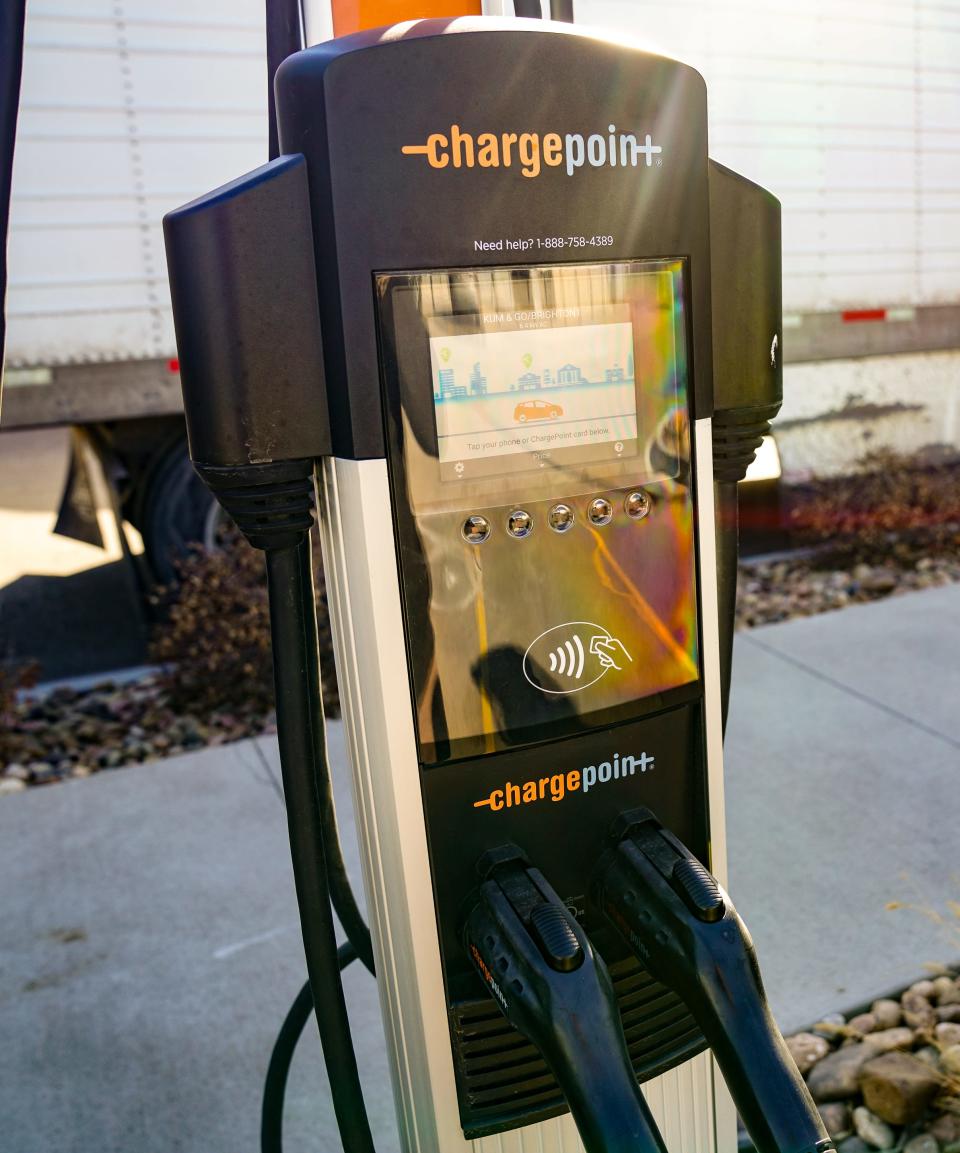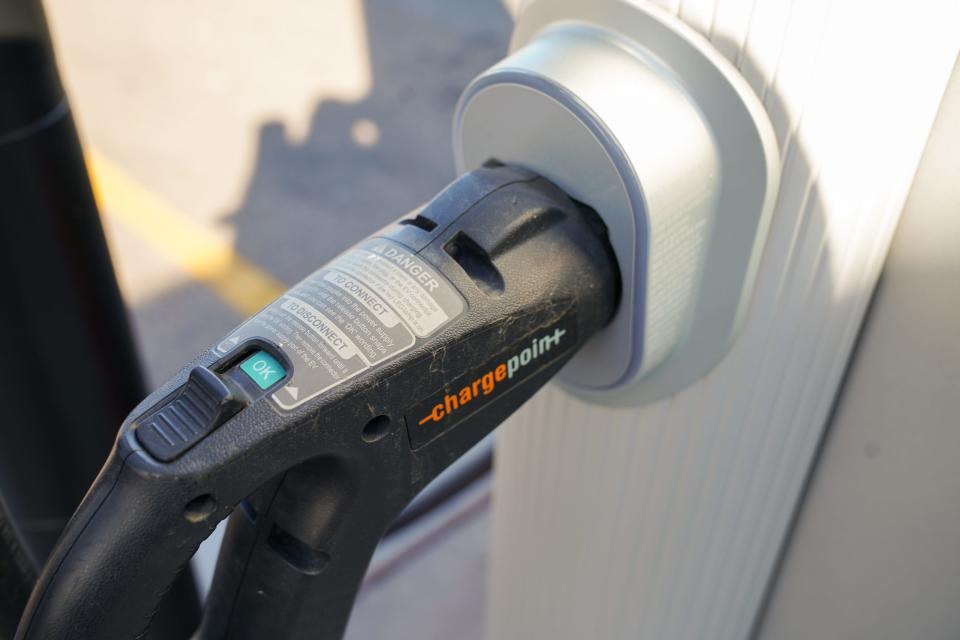A possible solution to a common problem with EVs: Just rewire your brain
DENVER ‒ Aaron Schlechter loves driving his electric pickup past the lines of cars and SUVs waiting to fuel up at Costco.
With a range of about 300 miles, his Ford F-150 Lightning recharges overnight or at his office during the day. Unless he's making a long drive with his family, he never needs to fill up.
"What I tell people is that it takes a little a bit of a shift," he said of driving a fully electric vehicle. "And the greatest thing is that you basically never have to charge when you're out ‒ your gas station is essentially at your house."
An EV fan since he got a Tesla in 2016, Schlechter is among the most experienced chargers of electric vehicles nationally. He enjoys the freedom of waking up to a fully charged vehicle at his home every day, one with the range to take him almost anywhere he needs to go.
But as a growing number of Americans are driving all-electric vehicles, some drivers' brains think differently about how they fill up: They're accustomed to the gas car experience of always being close to a pump that can fill their tank.
That means two things are happening simultaneously in America: Some new EV drivers who can charge at home are rewiring their brains, changing their expectations of their vehicle as Schlechter has done. And authorities are racing to make such a shift less necessary, building up an extensive network of chargers across the nation that also serve people who can't charge at home.
EVs face an understandable problem: 'range anxiety'
Experts have specifically identified the concept of "range anxiety" as a problem for many would-be EV drivers: The perceived fear of running out of battery power. However, federal statistics show that 92.5% of all trips Americans take - aside from commercial delivery trucks - are less than 25 miles, well within the range of every EV on the market today.
The major exception is holiday travel, and this year, AAA predicts about 104 million people will drive 50 miles or more to their holiday destinations.
Schlechter, who owns an electrical contracting company, said even a short period of driving an EV teaches people to adapt. He said EV critics talk more about range anxiety than he and his friends in Denver's Tesla club ever do. Critics also cite how cold weather can sap an EV's batteries, reducing its range.
He said drivers of gas-powered cars are quick to complain about how EVs work because they don't grasp the reality of how most people drive, which is short trips with plenty of time to recharge at home.
"The hypocrisy, the ignorance, is just amazing," Schlechter said. "I've been driving all-EV for more than seven years. I have a lot of miles and a lot of experience. And I've never once gotten stranded."
Experts echo Schlechter's perspective: "EV drivers get very good at figuring out range and charging strategy to the extent it’s not a huge deal to them except when weather hits," said Skyler McKinley, a spokesman for AAA Colorado. "Interestingly enough, and perhaps problematically from a policy perspective, most people don’t trifle with the public chargers."
The Biden administration argues the charging challenge is basically a chicken-and-egg situation: Without more chargers, people won't buy EVs. But private companies building EV chargers want to make sure there's enough demand to justify the investment, which can hit $20,000 for the fastest and most advanced chargers.
Schlechter said he's learned to adapt over the past few years when driving long distances. Sometimes he picks routes that aren't the most direct but take him past a fast charger, like when his family drove from Colorado to Yellowstone National Park during the pandemic. Other times, he said, he books hotels with chargers so the car is ready by morning, like on family mountain biking trips to Moab, Utah or Colorado's Black Canyon of the Gunnison National Park.
Still, even he admits to a bit of range anxiety, especially in rural areas: His new Lightning pickup can't yet use the Tesla chargers he's grown accustomed to stopping at.
"It's gotten a lot better and a lot easier but there's still a lot of gaps," he said. "It just takes a little bit of planning, and once you develop those habits, it becomes second nature."
Frustration is growing with EV chargers
While most EV drivers today can charge at home - because EVs have been typically more expensive and therefore limited largely to homeowners who could afford to install their own charger - newer EV drivers increasingly depend on outside networks. For those drivers who need to charge while away from home, having fast, reliable chargers conveniently located around town and across the nation is becoming a greater priority.
Reflecting that shift is the reality that as the number of people driving EVs has grown, so has dissatisfaction with charging options. While Schlechter and other early adopters understood the limitations of EVs, newer purchasers appear frustrated by public-use charging systems that are sometimes incompatible, slow or broken.
An August study by consumer-insights company J.D. Power found that overall satisfaction with relatively slow public chargers known as Level 2 dropped 16 points to 617, on a 1,000-point scale, from 2022, and the lowest since the survey began in 2021. Satisfaction with a faster kind of chargers also dropped 20 points in a year, to 654. And drivers were also increasingly frustrated with how long it took to charge their EVs.
Even more worrying, the survey said, 20% of drivers who stopped to charge simply gave up either because it would have taken too long or the charger was broken.
"The results of this year's study should be very concerning to all those involved in the transition from gas-powered vehicles to electric vehicles," Brent Gruber, the executive director of the EV practice at J.D. Power, said in announcing the results. “Although the majority of EV charging occurs at home, public charging needs to provide a much better experience across the board—not just for the users of today, but also to alleviate the concerns of skeptical future customers."
Today there's three kinds of charging systems: Level 1, Level 2 and "direct current fast charging," which is known as DCFS. Level 1, equivalent to a household outlet, can charge an EV in about 40 hours, while a Level 2 cuts that to about four hours. A DCFC charger like Tesla's can charge an EV in as little as 20 minutes. In contrast to filling up a gas tank, an EV battery charges very quickly when it's close to empty, but slower as it fills up.
Weeks after the J.D. Power survey was released, the Biden administration announced a special $100 million pool of funding to repair or replace broken chargers. And the first new chargers paid for by the Biden infrastructure law opened in Ohio earlier this month at a Pilot Travel Centers.
Earlier this year Tesla agreed to open portions of its charging network to other vehicles. Unlike gas station nozzles, which are standardized nationally, EV chargers aren't universal and sometimes require an adapter or approval from the vehicle itself. In addition to the competing standards, there's a growing concern among travel center operators and other businesses about why taxpayers and electric ratepayers are subsidizing charging stations that compete with privately installed ones.
Several legacy auto manufacturers, including Ford, have recently agreed to start making their vehicles compatible with the Tesla chargers in the coming years.
“Charging your electric vehicle should be as easy and convenient as filling up a gas tank – and this investment will make our EV charging network more reliable, full stop,” Federal Highway Administrator Shailen Bhatt said in September. “We’re building a bigger EV charging network to keep up with driver demand, and we’re also going to make sure the currently available network is working when you need a charge.”

Ongoing efforts to build a better network of EV chargers
National experts have identified the lack of comprehensive charging networks as one of the biggest obstacles to the purchase of EVs, in addition to concerns about cost. While it's hard in this country to drive more than a few miles without passing a gas station, there are still large regions, particularly in the sprawling West, where finding an EV charger requires advance planning.
President Joe Biden's signature infrastructure law aims to change that by providing $7.5 billion in tax dollars nationally to help strengthen the existing patchwork network, which today is dominated by Tesla's own-brand chargers.

Until recently, Tesla chargers could only charge Tesla vehicles, part of a vertically integrated system that made the vehicles the best-selling EVs in the United States. Most of the federal money for the new chargers is allocated to create a network along major roads and interstates, spaced 50 miles apart.
Nationally, EVs still represent only about 1% of all cars, SUVs and light-duty trucks, but the number of them on the roads is increasing rapidly, with about 2.3 million on the roads today, up from 1 million in 2020. Legacy U.S. automakers like GM, Ford and Stellantis are beginning to offer a wide variety of options, bringing their vast manufacturing scale into play to compete with Tesla and foreign manufacturers like Kia, Hyundai and Volkswagen.
In the third quarter of this year, almost 20% of new cars, SUVs and light trucks sold were EVs. Biden wants to raise that to 50% by 2030.
This article originally appeared on USA TODAY: Where am I going to charge my EV? The answer can be frustrating.

